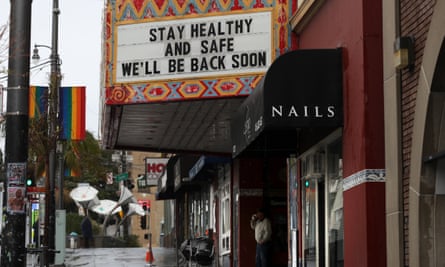San Francisco and five other counties in California issued a shelter-in-place order in an effort to curb the spread of coronavirus.
The order, which goes into effect at midnight on Tuesday until 7 April, is similar to the drastic lockdown measures taken in places like Italy, Spain, France and China, but it’s the first of its kind in the United States.
What does this shelter-in-place order do?
This order requires 6.7 million residents in San Francisco and five other Bay Area counties – Santa Clara, San Mateo, Alameda, Marin and Contra Costa – to stay home unless absolutely necessary.
Santa Cruz county issued a similar order later on Monday.
They can’t ever go outside?
Residents “may leave to provide or receive certain essential services or engage in certain essential activities and work for essential business or government services”.
The key word here is “essential”. Going to get groceries, seeking medical attention, bringing a dog to a veterinarian or picking up medication are all activities that officials consider essential. Residents working in the healthcare field will be able to go to and from their jobs. Workers with jobs such as garbage collection will be able to continue their work.
The order also allows for outdoor exercise, “provided that the individuals comply with social distancing requirements”.
“With this order in place, you will still be able to get food, care for relatives, run necessary errands and conduct the essential parts of your life,” said Dr Grant Colfax, the director of the San Francisco department of public health. “You will still be able to walk your dog or go on a hike alone or with someone you live with or even with another person as long as you keep six feet between you.”
What happens if residents don’t comply?
This is an order, not a recommendation or a guideline. By law, it is enforceable as a misdemeanor, and the order requests that the sheriff and chief of police “ensure compliance with and enforce this order”. “The violation of any provision of this order constitutes an imminent threat and creates an immediate menace to public health,” the order states.

“I do interpret that, in theory, that they could actually arrest somebody,” said Jonathan Holtzman, the former chief deputy city attorney in San Francisco. “As a completely practical matter, I do think that it’s very, very unlikely that a lot of people are going to get arrested under this because there are so many different functions that you could be performing that are exempted.” For example, any resident outside their home could very well be on their way to the grocery store, or engaging in outdoor exercise.
At a news conference, William Scott, the San Francisco police chief, said his officers planned on taking a “compassionate, commonsense approach” to the order and would use enforcement as a last resort.
What happens to retail and restaurants?
All businesses considered non-essential, like bars, shops and fitness centers, were ordered to close. Restaurants will remain open in only a takeout and delivery capacity. Grocery stores, hardware stores and pharmacies will stay open.
What about transit?
All non-essential travel “on foot, bicycle, scooter, automobile or public transit” is prohibited. Under the order, essential travel is categorized as traveling for necessary supplies, accessing healthcare or going to provide aid to family or friends. Airports, taxis, Uber, Lyft and public transit will continue running to service essential travel, but those using any mode of travel are expected to practice social distancing.
Why are these counties taking such an extreme measure?
California saw a 14% increase in positive coronavirus cases over the weekend, with 335 reported and six deaths. The majority of the cases have been in the Bay Area: 40 in San Francisco, 138 in Santa Clara county and 120 more in the neighboring counties. Half of the state’s coronavirus deaths were in the Bay Area.
Wait, didn’t the governor order something like this already?
The California governor, Gavin Newsom, issued an advisory calling for the closure of all bars, night clubs, breweries and wineries in the state, and for all Californians with chronic conditions and all seniors age 65 years or older to stay home. This advisory affects a $2.8bn nightlife industry with an estimated 4,765 businesses, as well as at least 5.3 million seniors – but it was only an advisory, as was his request that all gatherings of more than 250 or more be canceled or postponed.

He made a point to say that he felt that California had not reached the stage of a “police state” where officials need to enforce such guidelines, and noted that several jurisdictions had and could take the guidelines a step further as needed to suit their needs. “We are not a small isolated state – this is a nation state,” he said. “Santa Clara county’s conditions are extraordinarily different than Tulare’s, extraordinarily different than Madera’s, or Colusa’s. While it may be fanciful or comforting by perception standards to some to have one size fits all, that’s not the world in which we view the reality on the ground. There is no community spread in some communities. There is significant community spread in some communities.”
How do you shelter-in-place if you’re homeless?
In the six Bay Area counties that issued the order, an estimated 25,000 people are homeless. In Santa Cruz county, there are 2,167. The order exempts the homeless from having to shelter-in-place, but is “urging them to find shelter and government agencies to provide it”.
At Sunday’s news conference, Newsom said the state was working to procure hotels and motels for the homeless population living in encampments, as well as an additional 450 trailers.
Meanwhile, in San Francisco, there is currently a waitlist of 799 to get a shelter bed. More than 90 on that list are 65 years of age or older, and most vulnerable of exposure.
